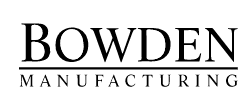Excercise to Try With Your Team
Step 1
Brainstorm what your Customers could do to make your life easier as their supplier (10 minutes…..and trust me, you could go for longer than that!)
Step 2
Narrow down the list to the Top 5 things your Team would appreciate the most (excluding things that are obviously clearly outside the control of your Customers)
Step 3
Review the list and see how many you do for your Vendors. Since you are their Customer, they would likely appreciate the same treatment from you that your Team would like from your Customers!
So, How Did You Do?
How many of your Top 5 do you do consistently for your Vendors?
We’d love to see your list (since we’re extremely interested in what you think … email it to andy@bowdenmfg.com if you get a chance) and hear how well you’re doing to set your Vendors up for success.
When we did this exercise with our Team, we suddenly found several things that we needed to do to be a better Customer for our Vendors.
Communication is usually an important part of the exercise and here are three keys to help keep your Vendors in a good spot and your Team in the loop on how they’re doing:
1. Build a Consistent Communication Rhythm
Having solid data on a consistent basis is important to any relationship. Intentionally setting up a consistent rhythm is pretty simple and it helps both sides of the relationship.
If you need to initiate it each time, set up your system to prompt you. If they can do it consistently without prompting, that’s great, but make sure you reply consistently to their information.
Solid relationships are built on consistent two-way communication and you need to make sure you’re providing them good information, as well as expecting updates each time.
We’ve found that weekly emails with open order information are a great starting place, but maybe bi-weekly is enough for you.
2. Establish Clear Points of Contact Between Your Team and Their Vendor Counterparts
Understanding how your Team would prefer to communicate is an important first step to this objective. Sometimes email is adequate and sometimes a phone call or Zoom session would be better.
Different types of communication should be directed back and forth between your two companies. For example, Purchase Orders typically go from your Purchasing department to the Vendor’s Sales contact or Administrative contact. Knowing the typical types of information that flow back and forth helps predict and establish those contacts and methods.
Often a main point of contact can be established, but just beware that you don’t create a mini “telephone game” that can muddle the messages back and forth.
Purchasing to Customer Service, Engineering to Engineering, and Quality to Quality are three typical connections we try to make sure are established to help smooth information flow.
3. During a Crisis or Delay, Clearly Communicate a More Frequent Update Schedule if You Need It
When things are behind schedule (more often now than in a long time with the current supply chain issues we’re all facing!) or a Customer is expediting, that can put more pressure on the information you’re getting from your Vendors.
Make sure you’re extremely clear about when you need updates.
In those times, the pressure is rolling downhill … from your Customer to you, to your Vendor……and if you always know when you’ll get the next update, you can keep the Customer in the loop.
It could be a daily end-of-day email or a first-thing-in-the-morning phone call.
Whatever might work best for you as you’re updating your Customer, spell it out for your Vendor and hold them to it.
Nothing is more frustrating up and down the supply chain than waiting for information and not being sure when you’re going to get it.
Final Thoughts
As you enter a time of crisis, always make sure you let your Vendor know when you need the next update, even if that update hasn’t changed. Everyone likes to know that they haven’t been forgotten and taking the time to communicate is important to prevent additional frustration.
If you follow these three Keys in managing the communications with your Vendors, you’ll be better equipped to deal with your Customers.
Once your Vendors start getting consistent information from you, they’ll appreciate your thoughtfulness and they’ll work harder to take care of you.
If you struggle to get them to respond, it may tell you more about them than you wanted to know……it might be time to look for a new vendor.
If you need more helpful information about dealing with your Vendors, our Manufacturing Supplier Checklist can help you see which ones are helping you the most, and which ones might not be adding to your cause. Check it out here.

